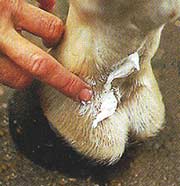
Cracked Heels in Horses - Causes, Prevention & Treatment

Apply an antiseptic cream to
heels once they have been
washed and thoroughly dried
Cracked Heels, also sometimes known as greasy heel or mud fever, are a common problem for horses, especially during the cold wet winter months.
The medical term for this cracked heels is "pastern dermatitis".
Cracked heels most often occur in horses and ponies which are turned out in a field for at least part of the day - but a few rides out on a muddy fields or bridlepath can also trigger the problem.
Washing a horse's legs can also be the cause of cracked heels if the legs are not properly dried afterwards.
Cracked heels are not actually cracks in the heel of the foot!
It is an equine skin condition which occurs in the hollow of the pastern where the horse's skin is particularly delicate.
Horses with white legs seem to be more likely to suffer from cracked heels than those with dark legs.
SIGNS AND SYMPTOMS OF CRACKED HEELS
The first signs of cracked heels are scurf and scabs in the hollow of the pastern.
Don't just look, but also feel for these daily when you pick you horse's feet out. It is easy at first to mistake these scabs for dried mud.
If you spot these symptoms early enough you should be able to treat the problem before it gets too serious.
If cracked heels aren't spotted in time the scabs may increase and can eventually cover a wide area.
When the scabs fall off, painful crackswill show underneath and may cause the horse to go lame.
Because the cracks are so low down the leg they can easily become infected.
It is quite tricky toapply dressings, and get them to stay on, to this part of the horse's leg. So if you can avoid letting the condition get to this stage so much the better.
MUD FEVER
Some horse owners refer to cracked heels as Mud Fever . This is a similar condition that generally affects a horse or pony higher up on the legs
HOW TO TREAT A HORSE WITH CRACKED HEELS ?
The first step in treating equine cracked heels is to bring the horse or pony into a clean dry area.
The scurf and scabs should then be washed off with a warm antiseptic solution. This may not be easy as the horse will be quite sore in this area and may not like you touching his legs.
If your horse is fairly hairy with a lot of feathers it may be best to to trim the long hair from his heels. Although the thick hair does give some protection to the legs in wet conditions it will make washing and drying the legs more difficult and may slow down the healing process.
When the heels are completely dry - use a hairdryer if necessary - apply a thick layer of equine antiseptic healing cream or ointment.
If possible keep the horse or pony stabled - unless you have a dry paddock or area to turn him in.
As well as preventing infection the cream will moisturise and soothe the heels in the same way that hand cream helps improve the condition of chapped skin in humans.
If your horse isn't lame he can be exercised but try to stay on dry land or roads and avoid riding across muddy fields and tracks.
HOW TO AVOID AND PREVENT CRACKED HEELS
A few basic precautions can help to prevent cracked heels:
- Spread a light coating of vaseline, petroleum jelly, udder cream or
baby oil over the horse's lower leg before you turn him out in wet muddy
conditions. This will act as a protective barrier.
You can also buy creams that are specially developed for horses to prevent mud fever which are very effective. - Always dry your horse or pony's legs after washing or if they come in wet from the field.
- If your horse or pony stands by a muddy gateway waiting to be brought in, spread a clean bale of straw to soak up the worst of the water and mud.